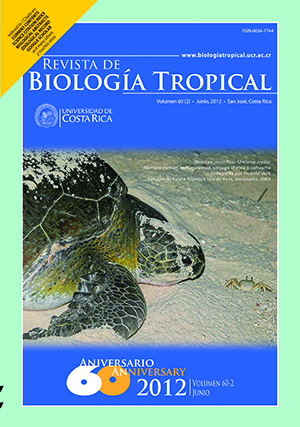Abstract
The life histories of succineids have received relatively little attention. To evaluate life history char- acteristics of Omalonyx matheroni, we studied a Brazilian population (Reserva Particular do Patrimônio Natural Feliciano Miguel Abdala, in Caratinga, Minas Gerais, Brazil) under laboratory conditions. The aims of the present study were (1) to describe in detail an appropriate rearing method; (2) to investigate the effects of different temperature and photoperiod conditions; and (3) to assess the effects of self and cross-fertilization on the repro- ductive biology of these mollusks. We studied the oviposition site, the time to sexual maturity and the influences of photoperiod and temperature on reproductive parameters of O. matheroni reared under laboratory conditions. We tested three combinations of temperature and photoperiod, designated A, B and C (A: 25oC, 24 hours of light; B: environmental conditions of temperature and photoperiod, characterized as follows: average maximum temperature=27.1oC, average minimum temperature=18.3oC, average day length=12.06 hours; and C: 25oC, zero hours of light) and two rearing densities (I: isolated and G: grouped) on reproductive parameters (number of eggs per egg mass, number of unviable eggs per mass, egg mass incubation period, and duration of the hatching period). A total of 186 individuals and 565 egg masses were studied. Data were analyzed by Student’s t-test, two-way ANOVA and Chi-Square test. Eight generations were produced (March/2004-March/2006), from 35 field specimens, 91% of 3 197 eggs hatched. The time to sexual maturity was approximately three months for individuals reared in groups or in isolation (Student’s t-test: t=1.41, df=31, p=0.16); however, they dif- fered significantly in weight (Student’s t-test: t=3.6, df=31, p<0.001). Regarding the influences of temperature and photoperiod on reproductive parameters, under natural environmental conditions, individuals produced a greater number of eggs per mass (ANOVA: F2,573=84.15, p<0.001), with a longer incubation period (ANOVA: F2;559=170.05, p<0.001). The extreme photoperiod conditions of 24 hours of light or zero hours of light likely imposed stress and could be related to the significant reductions in the number of eggs per mass, and egg incu- bation period as well as the increased synchrony in egg hatching. No correlations were observed between the number of unviable eggs per mass and the temperature, photoperiod (ANOVA: F2,573=0.87, p=0.92) or rearing density (ANOVA: F1,573=0.21, p=0.64). Individuals reared in isolation under natural conditions produced more eggs per mass and did not presented any disadvantage with respect to the variables analyzed as compared to the animals reared in groups. These results indicate that O. matheroni can successfully reproduce by selfing.Comments

This work is licensed under a Creative Commons Attribution 4.0 International License.
Copyright (c) 2012 Revista de Biología Tropical
Downloads
Download data is not yet available.






